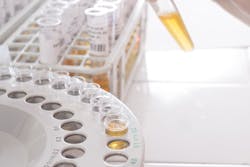There are two laboratory tests that have remained basically unchanged for 100 years: manual blood smear differential and urine microscopic analysis. The basic method for the urinalysis is the same as it has always been: centrifuge a standard volume of specimen; decant; examine the remaining sediment microscopically; then identify and enumerate what is seen. There have been slight refinements in such things as the sample volume, the centrifuge times, pipettes, slides, etc. But the basic premise has been unchanged, even with the introduction of automated urine particle analysis.
How we do it now
Many labs now rely on some automation, in the form of flow cytometric microscopic analysis, for the identification and enumeration of urine elements. The majority of automated results are acceptable without further checking or verification, but there will be a percentage of results that, depending on things such as the limits set by the user and the types of specimens, will require manual verification. For flow cytometric analyzers, five elements are identified and counted: WBCs, RBCs, squamous epithelial cells, bacteria, and hyaline casts.
Other elements may be detected with user-set flags, including yeast, pathological casts, crystals, and others. Because it is flow cytometry, it is very much like an automated hematology analyzer differential, which reports a five- or six-part differential, and other cells, such as blasts and atypical lymphs, indicated as suspect flags. In both cases, the operator has control over how sensitive these flags are, and even whether to use the flags at all.
In automated flow cytometry of urinalysis, the three elements responsible for most manual microscopic checks are yeast, pathologic casts, and hyaline casts. Hyaline casts, one of the five reported elements, benefit from a high-limit check, since the analyzers tend to overcount them. The other four parameters are accurate enough that no limits need be set. If a flag limit is exceeded, the report displays a review flag, and the presence and amount may need to be verified microscopically.
A cursory exam to simply verify the presence or absence of flagged elements is different from doing a complete manual microscopic, where there is no other reference than the strip result. This is analogous to doing a peripheral smear slide check on the automated differential, where, rather than do a 100-cell count, you quickly estimate the accuracy of the flagged result. If a full microscopic isn’t needed on an automated urinalysis result, is a spun sediment really necessary? For verifying automated results, can the spun microscopic be eliminated, and can unspun urine be used to check the results?
A better way? An experiment.
In our lab, we wanted to see if using unspun urine to verify flags for yeast, hyaline casts, and pathological casts would give reliable results, as compared to using the traditional spun urine sediment. We started this study with upper flagging limits based on two years of experience and recommendations from the manufacturer.
- Yeast 4.5/hpf
- Hyaline casts 12/lpf
- Pathological casts 7.4/lpf
These limits have given us a moderate false positive rate, which is preferable to missing too many positives. With these limits, we analyzed 60 samples with any of the three flags, and some samples had more than one flag. Out of 60 specimens, we had 22 true positives, and these are the ones we used to determine if the unspun urine gave different results than the spun sediment. (The false positives were of no use, since neither the spun nor unspun had any of the flagged elements, at least in numbers that we could detect).
As a rule of thumb, the estimate on the unspun urine was multiplied by 10 to extrapolate the results to the spun results. For example, if the unspun result showed two hyaline cast/lpf, the spun results should be around 20/lpf.
We confirmed what we already knew, that sometimes spinning the specimen actually works against identifying elements if the field is too crowded. And if a sample had very high levels of an element, these would be visible easily on unspun urine. It was the moderate and smaller levels that were of more concern.
We always examined the unspun sample first, to avoid bias from the spun sediment, although bias could work both ways: examining a positive spun sediment first might make one look more closely than usual to find something on the unspun no matter what, but looking at a negative unspun sample first might cause one to be less thorough on the spun sample. We decided to check the unspun first for consistency.
In every case where the flag was correct, the element could be seen in the unspun sample before finding it in the spun sediment. Therefore, our data indicates that, using careful criteria, the spun microscopic didn’t give us any better information than using an unspun specimen, and may be unnecessary when simply confirming presence of flagged elements.
Some further takeaways
It is important to note that the lower your flag limits, the more discrepancy you will find between spun and unspun results, because the elements will be harder to find in smaller numbers, and you will be flagging for increasingly insignificant numbers. Obviously setting the yeast flag at 2 per hpf is going to overflag; you will virtually never see yeast in the unspun sample, and you will only rarely see it on the spun. Setting reasonable limits, as in hematology automated differentials, is crucial to this system working.
We used this data as an opportunity to revise our flagging limits, with the goal of reducing the false-positive (FP) rate. This would mean raising the limits if the data so indicated. We took the lowest result that gave a true positive and adjusted the flag limit up to or just below that number. Based on the data, we were able to raise all three levels:
- Yeast 8/hpf
- Hyaline casts 15/lpf
- Pathological casts 10/lpf
This lowered our review rate slightly, from 20 percent to about 17 percent.
The implementation of any new data and limits should be made by an experienced laboratorian, with support from pathologist or medical staff, and with the recommendation from the instrument company specialists. Even after deciding on initial criteria, there will be some period of actually testing the numbers in “real life.”
Clinical laboratory professionals get a feel for whether they are doing too many manual microscopics or too many blood smear slide checks. If you think that is happening, it probably is. Most labs tailor slide check criteria too narrowly, and probably do too many urine microscopics as well. Treating an unspun urine check like a peripheral blood smear check can save time, labor, and money.
A graduate of St. Luke School of Medical Technology in Pasadena, California, Roy Midyett, CLS, has been supervisor of hematology at Presbyterian Hospital in Whittier, California, for 19 years.

